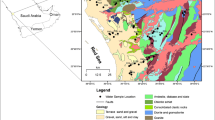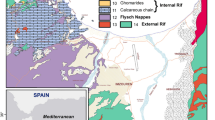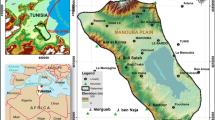Abstract
The groundwater hydrogeochemistry assessment has been carried out based on physic–chemical parameters (which are in situ and major ions) to observe the hydrochemical mechanism that might occur and control the groundwater chemistry changes. A total of 216 groundwater samples from Kapas Island were collected bimonthly during two different monsoon seasons which were South–West Monsoon known as pre-monsoon (August–October 2010) and North–East Monsoon known as post-monsoon (February–April 2011). Geochemical data on dissolved major constituents in groundwater samples from the Kapas Island revealed the main processes responsible for their hydrogeochemical evolution. The abundance of major ions revealed Ca > Na > Mg > K and HCO3 > Cl > SO4 dominations. Principal Component Analysis (PCA) extracts four (pre-monsoon) and three (post-monsoon) effective components which explained the origin of groundwater sources which have 81.6 and 78.9 % of total variances respectively. Comprised of variables TDS, EC, Salinity, Eh, pH, Cl, and Na in component 1, pre-monsoon experienced slightly saline process while component 1 in post-monsoon consist of Mg, TDS, EC, Salinity, Ca, Na, pH, Eh and HCO3 described the mineralization process of the geological matrix have taken place. Saturation indices of carbonate minerals were calculated using PHREEQC for window software; calcite, dolomite and aragonite solubility showed strong and positive correlationship value (p < 0.01) with Ca constituent respectively, also indicating mineralization processes.
Access provided by Autonomous University of Puebla. Download conference paper PDF
Similar content being viewed by others
Keywords
Highlights
-
The seasonal changes affect the groundwater quantity and quality.
-
Variation of major ions concentration in the hydrochemical processes.
-
PCA reveals the main controlling factors of groundwater composition.
-
PHREEQC calculation indicates mineralization processes.
Introduction
Small tropical islands became substantial issues regarding freshwater resources as its insularity character may expose to too many sources of defilement. The quality of fresh groundwater in small islands usually depends on the surrounding activities while, the presence of freshwater are based on its quantity, its surface storage and subsurface recharge (Aris et al. 2010). Groundwater pollution has been documented worldwide as results from anthropogenic disturbances into natural systems (Rosenthal et al. 1992). One of the most acute water resources problems in small tropical islands is the continuous salinization of groundwater. Seasonal changes have become vital contribution to groundwater hydrochemistry either in saline or freshening status. Therefore, a temporal distribution of seasons which are pre-monsoon (South–West Monsoon; dry season) and post-monsoon (North–East Monsoon; particularly wet season) were taken into consideration in present study (Desa and Niemczynowicz 1996; Wong et al. 2009). The objective of this paper is to determine the controlling factors affecting the groundwater hydrochemistry especially in different season.
Materials and Methods
Kapas Island is located at 5° 13.140′ N, 103° 15.894′ E with an area about 2 km² (Abdullah 1981; Shuib 2003). The climate is typically tropical climate with annual rainfall between 451 and 1102 mm. Kapas Island experiences constant mean temperature at 29.88 °C and has average daily relative humidity around 70–80 %.
The sampling design for this study was based on spatial and temporal scales. A total of 216 groundwater samples with replicates were collected bimonthly from six constructed boreholes during pre-monsoon (August–October 2010) and post monsoon (February–April 2011) at Kapas Island.
Results and Discussion
The cation concentrations order were Ca > Na > Mg > K while for anions were HCO3 > Cl > SO4. As different monsoons were concern, two types of groundwater were found during pre-monsoon which are Ca–HCO3 and Na–HCO3 while post-monsoon is having only Ca–HCO3 type.
Principal component analysis (PCA) was used in this study to reduce large of dataset by explaining the correlation among variables (Stetzenbach et al. 1999; Yongming et al. 2006). Pre and post-monsoon extract four and three components with 81.6 and 78.9 % of total variances respectively. Pre-monsoon shows salinization processes while having components TDS, EC, Salinity, Eh, pH, Cl, and Na. On the contrary, variables components viz. Mg, TDS, EC, Salinity, Ca, Na, pH, Eh and HCO3 during post-monsoon described the mineralization process. Figure 32.1 shows the distribution of components in different monsoons.
Saturation indices (SI) indicate the behavior of carbonate minerals in groundwater. Most of groundwater samples during pre-monsoon are in dissolution state with 76 %. Meanwhile, the limitation of CO2 during post-monsoon explained the super-saturation of carbonate minerals and only 30 % of dolomite mineral were found in dissolution state.
Conclusion
Present study indicated that the geostatistical tool of PCA and geochemical technique of SI rendered an important data reduction to identify the factor controlling groundwater hydrochemistry especially in seasonal variation. Comprise of two different groundwater types; Ca–HCO3 (pre-monsoon) and Na–HCO3 (post-monsoon), these analyses revealed the most significant factors responsible to groundwater evolution which are salinization and mineralization processes.
References
Abdullah MP (1981) Laporan Penyiasatan Kajibumi; Ibu Pejabat Penyiasatan Kajibumi. Malaysia
Aris AZ, Abdullah MH, Praveena SM, Yusoff MK, Juahir H (2010) Extenuation of saline solutes in shallow aquifer of a small tropical island: a case study of Manukan island, North Borneo. Environ Asia 3 (Special Issue): 84–92
Desa MN, Niemczynowicz J (1996) Temporal and spatial characteristics of rainfall in Kuala Lumpur. Malays Atmos Res 42(1–4):263–277
Rosenthal E, Vinokurov A, Ronen D, Magaritz M, Moshkovitz S (1992) Anthropogenically induced salinization of groundwater: a case study from the coastal plain aquifer of Israel. J Contam Hydrol 11(1–2):149–171
Shuib MK (2003) Transpression in the strata of Pulau Kapas, Terengganu. Bull Geol Soc Malays 46:299–306
Stetzenbach KJ, Farnham IM, Hodge VF, Johannesson KH (1999) Using multivariate statistical analysis of groundwater major cation and trace element concentrations to evaluate groundwater flow in a regional aquifer. Hydrol Process 13(17):2655–2673
Wong CL, Venneker R, Uhlenbrook S, Jamil ABM, Zhou Y (2009) Variability of rainfall in Peninsular Malaysia. HESS 6:5471–5503
Yongming H, Peixuan D, Junji C, Posmentier ES (2006) Multivariate analysis of heavy metal contamination in urban dusts of Xi’an, Central China. Sci Total Environ 355(1–3):176–186
Acknowledgments
This study was funded by Ministry of Higher Education, Vote no. 07/11/09/696FR. The provision of allowance Graduate Research Funding (GRF) by Universiti Putra Malaysia and MOHE Budget Mini Scholarship is gratefully acknowledged. The valuable help from Faculty of Environmental Studies and Faculty of Engineering, Universiti Putra Malaysia, in completing this research.
Author information
Authors and Affiliations
Corresponding author
Editor information
Editors and Affiliations
Rights and permissions
Copyright information
© 2014 Springer Science+Business Media Singapore
About this paper
Cite this paper
Isa, N.M., Aris, A.Z. (2014). Application of Geochemical and Geostatistical Analyses in Observing the Controlling Factors of Groundwater Compositions. In: Aris, A., Tengku Ismail, T., Harun, R., Abdullah, A., Ishak, M. (eds) From Sources to Solution. Springer, Singapore. https://doi.org/10.1007/978-981-4560-70-2_32
Download citation
DOI: https://doi.org/10.1007/978-981-4560-70-2_32
Published:
Publisher Name: Springer, Singapore
Print ISBN: 978-981-4560-69-6
Online ISBN: 978-981-4560-70-2
eBook Packages: Earth and Environmental ScienceEarth and Environmental Science (R0)





